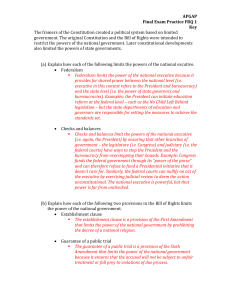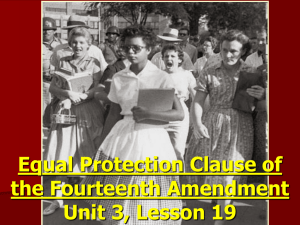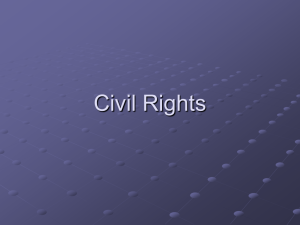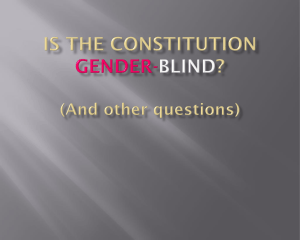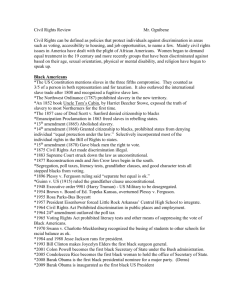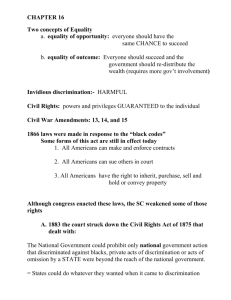File - Ms. Thompson American Government
advertisement
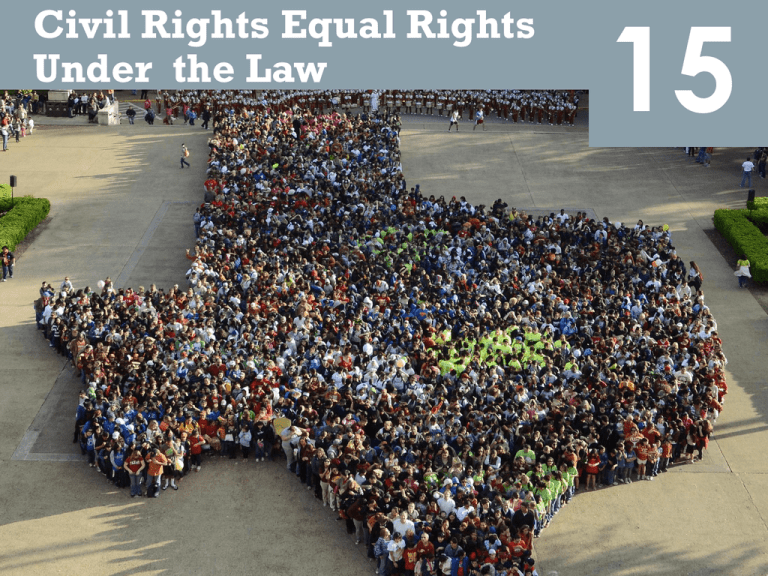
Civil Rights Equal Rights Under the Law 15 Video: The Big Picture 15 http://media.pearsoncmg.com/ph/hss/SSA_SHARED_MED IA_1/polisci/presidency/Magleby_Ch15_Civil_Rights_Seg1 _v2.html Video: The Basics 15 http://media.pearsoncmg.com/ph/hss/SSA_SHARED_MED IA_1/polisci/presidency/Seg2_CivilRights_v2.htm I. Equality and Equal Rights 15.1 A. Americans firmly believe in equality of opportunity regardless of race, ethnic origin, religion, sex, or sexual orientation. B. Political attention is focused on eliminating existing inequalities. C. Americans do not agree on equality of results Video: In Context 15.1 http://media.pearsoncmg.com/ph/hss/SSA_SHARED_MED IA_1/polisci/presidency/Seg3_CivilRights_v2.html A. How Citizenship Is Acquired and Lost 15.1 1. Naturalization (legal act conferring citizenship) a. Prior to 1865, states determined citizenship b. 14th Amendment provided definitions c. State or federal court (as well as the U.S. Citizens and Immigration Service) can grant U.S. citizenship 2. Dual Citizenship a. Each country has its own citizenship criteria b. For children of U.S. citizens born abroad Table 15.1: Requirements for naturalization 15.1 B. Rights of U.S. Citizens 15.1 1. Most rights come from state citizenship and confer the most important rights 2. Rights of national citizenship only grants freedoms to travel, petition the government, and vote 3. War-time rights can be restricted, excluding the Bill of Rights a. 1941 Internment of Japanese-Americans Japanese American citizens during World War II 15.1 C. Rights of Resident Aliens 15.1 1. Aliens may be expelled for minor infractions or detained during deportation hearings 2. Aliens enjoy fundamental freedoms relating to speech, religion, due process, etc. 3. Aliens can be denied benefits and employment 4. Children of illegal immigrants have the right to attend public school 15.1 Which of the following can grant U.S. citizenship? a. A state court b. A federal court c. The U.S. Citizenship and Immigration Services d. All of the above 15.1 15.1 Which of the following can grant U.S. citizenship? a. A state court b. A federal court c. The U.S. Citizenship and Immigration Services d. All of the above 15.1 II. The Quest for Equal Justice Citizenship rights have expanded since the nation’s founding . . . 15.2 A. Racial Equality 15.2 1. Segregation and White Supremacy remained after the civil war until the 1960s 2. Legal challenges began in the 1930s culminating with Brown v. Board of Education 1957 3. Truman desegregated the Armed Forces and Federal Government 4. Federal Civil Rights Act in 1957 made it a crime to intimidate or threaten African Americans exercising their right to vote. Civil rights activists march in Selma 15.2 B. Women’s Rights 1. Suffrage movement a. Seneca Falls Women’s Rights Convention in 1848 b. 19th Amendment ratified in 1920 2. Civil Rights Act 1964 a. Included protection against sexual discrimination 3. Equal Rights Amendment (ERA) a. Failed to be ratified 15.2 FIGURE 15.1: Percentage of Bachelor’s Degrees Awarded, by Sex 15.2 C. Hispanics 1. Legally sanctioned discrimination 2. Non-white immigration met with suspicion 3. Operation “Wetback” 1954 deported US born US citizens 4. 2012 Supreme Court upheld AZ law requiring police to check citizenship status 5. Hispanic majority in CA and TX which influences the electorate 15.2 Illegal Immigration 15.2 C. Asian Americans 15.2 1. Chinese Americans (10 million) a. Naturalization Act of 1906 which made it impossible for Asians to become US citizens. b. Repealed in 1943 c. Further amendment made in 1965 ending nationality criteria 2. Japanese Americans a. Early 20th c. laws against owning land, attending school b. Internment during WWII D. Native Americans 15.2 1. Indian Removal Act in 1830 forcibly moved to reservations 2. Granted US citizenship in 1924 3. American Indian Movement protested discrimination (housing, employment, education) 4. Poverty and unemployment still exist 15.2 Which of the following granted women the right to vote? a. The 19th Amendment b. The 14th Amendment c. The Voting Rights Act d. The Civil Rights Act 15.2 15.2 Which of the following granted women the right to vote? a. The 19th Amendment b. The 14th Amendment c. The Voting Rights Act d. The Civil Rights Act 15.2 15.3 III. Equal Protection of the Laws: What Does It Mean? 1. According to the 14th amendment no STATE can DENY a person “equal protection of the laws.” Individuals must be treated equally regardless of race 2. The 5th amendment, “due process clause” imposes the same restrictions on the federal government 3. Clauses apply to the actions of government, not individuals 4. Created to prevent government discrimination of certain classifications of groups Classifications -Supreme Court must differentiates among classifications: race, gender, age, poverty, disability, sexual orientation -Must determine if classification is “reasonable” or “unreasonable” -In general, a classification is unreasonable when there is no relationship between the classes it creates and permissible governmental goals. A. Constitutional Classifications and Tests 15.3 1. The Rational Basis Test a. Legislation must meet a reasonable government interest. b. Process engages the govt. in substantive due process. c. Romer v Evans (CO vote in 1996) sexual orientation could not be denied as a protected classification 1. Strict Scrutiny a. Law must have “compelling governmental interest” to justify classification 2. Suspect Classifications a. court applies strict scrutiny test in order to subject certain individuals as politically powerless b. For example, laws giving employment preference based on race. 3.Quasi-Suspect Classifications and Heightened Scrutiny a. law most show “important governmental objectives” A. Constitutional Classifications and Tests 15.3 1. Poverty and Age: considerable amount of legal debate regarding these classifications. a. inequality of schools b. age is a state issue not federal 2. Sexual Orientation: recent cases have raised the profile. 3. Fundamental Rights are explicitly and implicitly guaranteed and discrimination of these are subjected to Strict Scrutiny Table 15.2: Major Civil Rights Laws 15.3 Same-sex marriage 15.3 Video: In the Real World 15.3 http://media.pearsoncmg.com/ph/hss/SSA_SHARED_MED IA_1/polisci/presidency/Seg5_CivilRights_v2.html 15.3 All the following require a governmental burden of interest EXCEPT a. Rational basis test b. Strict scrutiny test c. Quasi strict scrutiny test d. Heightened scrutiny test 15.3 15.3 All the following require a governmental burden of interest EXCEPT a. Rational basis test b. Strict scrutiny test c. Quasi strict scrutiny test d. Heightened scrutiny test 15.3 Explore Civil Rights: Are All Forms of Discrimination the Same? 15.3 http://media.pearsoncmg.com/long/long_magleby_mpslgb p_25/pex/pex15.html IV. Voting Rights Protecting Voting Rights The Voting Rights Act of 1965 15.4 A. Protecting Voting Rights 15.4 1. Changes in the 1940’s due to increased African American political presence in cities a. 1944 Smith v Allwright declared White Primary unconstitutional b. 1960 racial gerrymandering declared unconstitutional c. 1964 poll tax eliminated (24th amendment) 2. Voting Rights Act of 1965 a. prohibits voting qualifications that resulted in a denial of the right of any citizen to vote on account of race. b. prohibits threats or intimidation c. department of justice must review changes in voting practices or laws d. 2013 Supreme Court declared review unconstitutional Gerrymandering 15.4 15.4 Which of the following prohibits the use of poll tax? a. The Civil Rights Act b. The 14th Amendment c. The “due process” clause d. The 24th Amendment 15.4 15.4 Which of the following prohibits the use of poll tax? a. The Civil Rights Act b. The 14th Amendment c. The “due process” clause d. The 24th Amendment 15.4 V. Rights to Equal Access: Accommodations, Jobs, and Homes 15.5 -After Reconstruction, the Supreme Court upheld government sanctioned discrimination most famously in Plessy v Ferguson (separate but equal) -The court’s interpretation of the Commerce Clause allowed the federal government to legitimize legislation which made public discrimination based on race, religion, or national identity a federal crime. 1. 1964 CIVIL RIGHTS ACT AND PLACES OF PUBLIC ACCOMMODATION -ALL PUBLIC ESTABLISHMENTS MUST BE OPEN TO ALL CUSTOMERS 2. 1964 CIVIL RIGHTS ACT AND EMPLOYMENT -BARRED DISCRIMINATION IN THE WORK PLACE 3. FAIR HOUSING ACT AND AMENDMENTS -HOUSING PATTERNS CONTINUE TO BE SEGREGATED EVEN THOUGH RESTRICTIONS HAVE BEEN REMOVED 15.5 Which of the following was used by the Supreme Court in interpreting civil rights legislation? a. The equal protection clause b. The due process clause c. The commerce clause d. The necessary and proper clause 15.5 15.5 Which of the following was used by the Supreme Court in interpreting civil rights legislation? a. The equal protection clause b. The due process clause c. The commerce clause d. The necessary and proper clause 15.5 VI. Education Rights -National Association for the Advancement of Colored People’s (NAACP) Legal Defense Fund (LDF), began filing lawsuits challenging the “separate but equal” doctrine in the late 1930s 15.6 A. The End of “Separate but Equal”: Brown v. Board of Education 1. Brown v. the Board of Education 1954 a. segregation is itself discrimination b. Decision based on 14th Amendment c. Instigated school desegregation 2. Title VI enforcement 1964 a. authority to withhold all federal funding to schools, school districts, or states practicing discrimination 15.6 B. From Segregation to Desegregation—But Not yet Integration 15.6 1. Court-ordered busing only if it was undertaken to remedy the consequences of officially sanctioned segregation (de jure segregation) 2. Busing could not be forced if segregation was the result of social and economic conditions (de facto segregation) 3. 1990s: Return of school controls to States Brown v. Board of Education 15.6 C. The Affirmative Action Controversy 15.6 1. Affirmative action programs a. The attempt to remedy 250 years of government sanctioned discrimination b. Extremely controversial 2. University of California Regents v. Bakke a. Supreme Court finds racial quotas to be unconstitutional b. But a University may properly take race and ethnic background into consideration when reviewing applicants C. Reaffirming the Importance of Diversity 15.6 1. 2003 re-affirmation of Bakke 2. Voter initiative against affirmative action programs 3. Pending cases for Supreme Court involve affirmative action questions 4. Most recent case upheld at University of Texas a. universities are allowed to consider diversity a compelling interest that justify race-based admission policies b. Equal Protection Clause does not require that state universities be blind to the history of overt discrimination Affirmative Action 15.6 Video: Thinking Like a Political Scientist 15.6 http://media.pearsoncmg.com/ph/hss/SSA_SHARED_MED IA_1/polisci/presidency/Seg4_CivilRights_v2.html 15.6 Which of the following 15.6 challenged the segregation of schools? a. Brown v the Board of Education b. University of California Regents v. Bakke c. Plessy v. Ferguson d. Marbury v. Madison 15.6 Which of the following 15.6 challenged the segregation of schools? a. Brown v the Board of Education b. University of California Regents v. Bakke c. Plessy v. Ferguson d. Marbury v. Madison D. Equal Rights Today 1. Victories just for the middle class and not the poor. 2. Segregation rising for Hispanics and Asians 3. The challenge of the government, the public, and individuals in providing equal opportunities to all citizens will be to continue to address those inequities as they widen across class, as well as socioracial, distinctions. 15.7 15.7 Which group benefits least from increases in civil rights protection? a. Women b. The middle-class c. The poor d. The handicapped 15.7 15.7 Which group benefits least from increases in civil rights protection? a. Women b. The middle-class c. The poor d. The handicapped 15.7 Explore the Simulation: You Are a Mayor 15.7 http://media.pearsoncmg.com/long/long_longman_media _1/2013_mpsl_sim/simulation.html?simulaURL=6 Discussion Question How have recent changes in civil rights, such as marriage laws, changed society? How have they affected your life? 15 Video: So What? 15 http://media.pearsoncmg.com/ph/hss/SSA_SHARED_MED IA_1/polisci/presidency/Magleby_Ch15_Civil_Rights_Seg6 _v2.html

